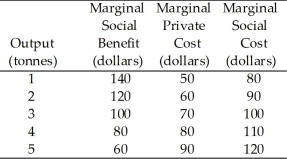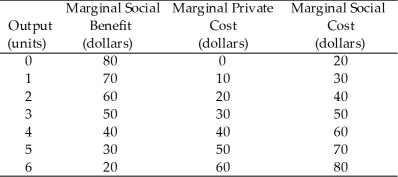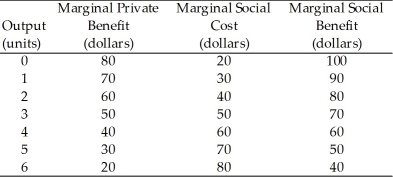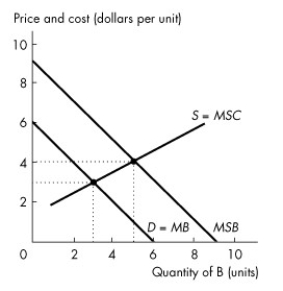A) marginal social benefit from paper is equal to zero.
B) marginal social cost of the pollution from making paper is equal to zero.
C) marginal private cost of the pollution from making paper is equal to zero.
D) marginal private cost of paper equals the marginal private benefit from paper.
E) marginal social benefit from paper is equal to the marginal social cost of paper.
G) D) and E)
Correct Answer

verified
Correct Answer
verified
Multiple Choice
A chemical factory and a fishing club share a lake.Producing chemicals creates water pollution that harms the fish.Initially the lake is owned by no one.Keeping in mind the Coase theorem, suppose transactions costs are low and the chemical factory is given ownership of the lake.Compared to the situation with no property rights, the quantity of chemicals produced
A) decreases.
B) stays the same.
C) increases.
D) changes but the direction of the change is unknown.
E) decreases only if the marginal external benefit decreases.
G) D) and E)
Correct Answer

verified
Correct Answer
verified
Multiple Choice
Use the figure below to answer the following questions.
 Figure 16.2.1
-Refer to Figure 16.2.1.The figure shows the marginal private cost curve, the marginal social cost curve and the market demand curve.If a constant per unit tax is imposed that generates an efficient allocation of resources, then producers receive a per unit price of
Figure 16.2.1
-Refer to Figure 16.2.1.The figure shows the marginal private cost curve, the marginal social cost curve and the market demand curve.If a constant per unit tax is imposed that generates an efficient allocation of resources, then producers receive a per unit price of
A) zero.
B) P₄.
C) P₃.
D) P₂.
E) P₁.
G) A) and B)
Correct Answer

verified
Correct Answer
verified
Multiple Choice
Use the figure below to answer the following questions.
 Figure 16.2.3
-Refer to Figure 16.2.3.A tax of ________ per tonne is necessary to achieve the efficient output of ________ tonnes of paper.
Figure 16.2.3
-Refer to Figure 16.2.3.A tax of ________ per tonne is necessary to achieve the efficient output of ________ tonnes of paper.
A) $14; 50
B) $14; 30
C) $13; 40
D) $2; 50
E) $2; 40
G) A) and D)
Correct Answer

verified
Correct Answer
verified
Multiple Choice
Choose the incorrect statement.
A) A patent encourages invention.
B) A patent encourages innovation.
C) A patent has an economic cost.
D) A patent creates a negative externality.
E) A patent produces a monopoly.
G) All of the above
Correct Answer

verified
Correct Answer
verified
Multiple Choice
The Coase theorem states that
A) patents and copyrights will solve the problem of external costs.
B) taxes will solve the problem of external costs.
C) global warming is hard to solve due to the prisoners' dilemma aspect of the problem.
D) property rights are social arrangements governing ownership, use and disposal of factors of production and goods and services.
E) if property rights are established, and if only a small number of parties are involved, and if transactions costs are low, then private transactions are efficient.
G) A) and B)
Correct Answer

verified
Correct Answer
verified
Multiple Choice
Use the table below to answer the following questions.
Table 16.2.2
Chemical Fertilizer Market
 -Refer to Table 16.2.2.If the fertilizer market is perfectly competitive and unregulated, output (in tonnes) is
-Refer to Table 16.2.2.If the fertilizer market is perfectly competitive and unregulated, output (in tonnes) is
A) 1.
B) 2.
C) 3.
D) 4.
E) 5.
G) All of the above
Correct Answer

verified
Correct Answer
verified
Multiple Choice
Use the table below to answer the following questions.
Table 16.2.1
 -Refer to Table 16.2.1.Given in the table are the marginal private cost and the marginal social cost of the production of chemical fertilizer and the marginal social benefit from the consumption of fertilizer.If the market is unregulated
-Refer to Table 16.2.1.Given in the table are the marginal private cost and the marginal social cost of the production of chemical fertilizer and the marginal social benefit from the consumption of fertilizer.If the market is unregulated
A) the quantity produced is the efficient quantity.
B) the quantity produced is greater than the efficient quantity.
C) the quantity produced is less than the efficient quantity.
D) marginal external cost is maximized.
E) production is technologically inefficient.
G) A) and C)
Correct Answer

verified
Correct Answer
verified
Multiple Choice
Use the table below to answer the following questions.
Table 16.3.1
 -Refer to Table 16.3.1.The table shows marginal private benefit and the marginal social benefit from the consumption of chemical fertilizer and the marginal social cost of the production of fertilizer.An efficient quantity is produced if the government
-Refer to Table 16.3.1.The table shows marginal private benefit and the marginal social benefit from the consumption of chemical fertilizer and the marginal social cost of the production of fertilizer.An efficient quantity is produced if the government
A) subsidizes production by $20 per unit.
B) subsidizes production by $10 per unit.
C) provides vouchers for consumption of $20 per unit.
D) taxes production by $10 per unit.
E) either A or C.
G) A) and E)
Correct Answer

verified
Correct Answer
verified
Multiple Choice
All of the following statements are correct except
A) knowledge about one process spills over into other segments of the economy.
B) additional knowledge makes people more productive, and there seems to be no tendency for the additional productivity from additional knowledge to diminish.
C) knowledge has no external benefit.
D) knowledge might be an exception to the principle of diminishing marginal benefit.
E) it is necessary to use public policies to ensure that those who develop new ideas have incentives to encourage an efficient level of effort.
G) A) and E)
Correct Answer

verified
Correct Answer
verified
Multiple Choice
When individuals make decisions about how much schooling to obtain, they
A) do not consider the personal benefits that education creates.
B) overvalue the personal benefits that education creates.
C) overvalue the external benefits that education creates.
D) do not consider the external benefits that education creates.
E) set marginal social benefit equal to tuition.
G) B) and D)
Correct Answer

verified
Correct Answer
verified
Multiple Choice
Use the figure below to answer the following questions.
 Figure 16.3.2
-In Figure 16.3.2.The figure shows the market for good B.Which of the following government policies creates an efficient outcome?
Figure 16.3.2
-In Figure 16.3.2.The figure shows the market for good B.Which of the following government policies creates an efficient outcome?
A) Tax the production of B by $3 per unit.
B) Tax the production of B by $4 per unit.
C) Provide vouchers for consumption of B of $1 per unit.
D) Provide vouchers for consumption of B of $3 per unit.
E) Provide vouchers for consumption of B of $4 per unit.
G) A) and C)
Correct Answer

verified
Correct Answer
verified
Multiple Choice
Use the table below to answer the following questions.
Table 16.3.1
 -Refer to Table 16.3.1.The table shows marginal private benefit and the marginal social benefit from the consumption of chemical fertilizer and the marginal social cost of the production of fertilizer.If production is left to the private market, the market price is
-Refer to Table 16.3.1.The table shows marginal private benefit and the marginal social benefit from the consumption of chemical fertilizer and the marginal social cost of the production of fertilizer.If production is left to the private market, the market price is
A) $70 a unit.
B) $60 a unit.
C) $50 a unit.
D) $40 a unit.
E) $30 a unit.
G) A) and C)
Correct Answer

verified
Correct Answer
verified
Multiple Choice
Complete the following sentence.Knowledge
A) generates external benefits.
B) generates external costs.
C) displays diminishing marginal benefit.
D) is encouraged by intellectual property rights.
E) A and D are correct.
G) B) and E)
Correct Answer

verified
Correct Answer
verified
Multiple Choice
The Coase theorem tells us that in the presence of external costs in production,
A) the government must intervene in the market to assure that the efficient level of output is produced.
B) private parties can negotiate to produce the good at a level where marginal willingness to pay for the good by consumers is zero.
C) private parties can never arrive at the efficient solution.
D) then under certain conditions, private parties can arrive at the efficient solution without government involvement.
E) and if transactions costs are high, then only the private sector will be able to produce the efficient amount of the good.
G) C) and D)
Correct Answer

verified
Correct Answer
verified
Multiple Choice
An example of an activity that creates a negative consumption externality is
A) logging, which pollutes rivers.
B) locating beehives next to an orange orchard.
C) smoking, which harms the health of a bystander.
D) a flu vaccination.
E) a sales tax.
G) A) and B)
Correct Answer

verified
Correct Answer
verified
Showing 101 - 116 of 116
Related Exams